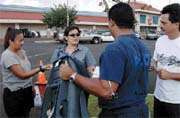When the Kaua’i Keiki Injury Prevention Coalition formed in 1994, its members was astounded to discover many Kaua’i children were at high risk of being killed or seriously injured in auto accidents because they weren’t properly restrained in a safety
When the Kaua’i Keiki Injury Prevention Coalition formed in 1994, its members was astounded to discover many Kaua’i children were at high risk of being killed or seriously injured in auto accidents because they weren’t properly restrained in a safety car seat.
Because of recent publicity on the importance of using child safety seats, the number of Kaua’i toddlers at risk while in vehicles has dropped from 60 to 30 percent.
Wanting to make a bigger impact, the coalition conducted another check-up yesterday in the parking lot of the K-Mart in Lihu’e.
Volunteers flagged down vehicles with child safety seats and went through a safety list on the seats and how to use them properly. The coalition expected to inspect 40 vehicles in two hours.
“Our goal is to build our community’s capacity to help parents with their child car seats before a crash occurs that will leave a child seriously injured or dead,” said Mary Jo Sweeney, a state Department of Health nurse and coalition member.
But even with more public awareness on the need to use the child safety seats, some parents still drive around in a way that exposes their children to danger, Sweeney said.
“I still see toddlers with parents in the back of trucks,” Sweeney said. “It is very bad.”
Even among those using the child safety seats, the seats are not properly anchored to autos and harness seats aren’t fasten tightly enough, Sweeney said.
“During a crash, kids will fly into the car seat in front of them and be ejected,” Sweeney said.
But in one “success story,” Sweeney said, a mother had gone to the American Medical Response station in Lihu’e to have a safety seat installed properly.
A day later, she got into accident, but she survived because she used seat belts, and her child survived because the seat had been anchored properly to the her vehicle, Sweeney said.
The law acts an incentive for parents to use the seats properly, she said. Effective July 1, 1999, all children under the age of 4 are required to be in a child safety seat. Fines of up to $100 also are possible.
During the check-up, coalition volunteers checked whether child safety car seats had been recalled, harness straps were properly positioned and safety seats were installed properly.
Volunteers also told motorists to have 1-year-old children in safety seats put in the back of autos facing the rear window, reducing the risk of serious or fatal injuries in the event of an accident.
Magnolia Banquel of Kapa’a was glad she stopped by the checkup point. Grandmother of a 22-month boy, Banquel bought a child safety seat she thought would fit him perfectly.
She was told the seat — for a child weighing 30 to 80 pounds — was too big for her grandson, and that it would be better to buy a smaller seat.
“If they had not been here to tell me that, and my grandson got into an accident and got hurt, I guess I would be the one who would be blamed, and I would have to sue the manufacturer,” she said. “This way, I know for sure. It will save a lot of money and grief.”
Over the past 6 six years, the coalition has checked 1,000 safety seats and vehicles.
The coalition members include Kaua’i police officers, Kaua’i firefighters, American Medical Response paramedics, members of the State Farm Insurance office in Kapa’a, nurses and volunteers.
Certified safety car seat instructors, including Sweeney, Maui Lt. Charles Hirata and John Kaizuka from the Big Island, worked with people who wanted to become certified technicians to conduct safety seat checkups on Kaua’i in the future.
Staff writer Lester Chang can be reached at 245-3681 (ext. 225) and mailto:lchang@pulitzer.net



